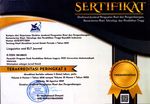The Use of Picture in Teaching Degrees of Comparison
Abstract
The objective of this quantitative study is to investigate whether there any influence of using a picture in teaching degree of comparison or not and to know the students’ responses at the second year students of SMP Negeri 9 Mataram in academic year 2014/2015. The population of this study was taken from all the second year students. The writer chose two classes to compare by using the technique of taken sample “cluster random sampling.” The first class as the experimental class (A class) was taught by the degree of comparison through pictures. The second class as a control class ( B class) was taught without pictures. While 34 students of the experimental group and 34 students of the control group. This study used an experimental study with a quantitative method — the data collected procedure by test and questionnaire. The writer gave the pre_test, the treatment, the post_test, and the questionnaire. After collecting and calculating the data, the writer found out that the experimental class gains a high score than the control class. Based on the result, the means scores of A class was 25 while the B class was 16. Moreover it was found that the value of t_test was higher than t_table, where t_test 2, 5 ≤ t_table = 2, 0 (0, 5% or 95%). The finding showed that there any influence of using the picture in teaching comparison degrees. The picture increases students’ responses to learning degree of comparison the class and also given good influence concerning students’ skill in mastering the subject of comparison degrees. It showed by students’ responses of the data from the questionnaire that more than half of students answer yes with percentage was 73%. It means that the picture has a great contribution for students in learning comparison degrees. Therefore, it can be concluded that Ha is accepted and H0 is rejected.
Keywords
Full Text:
PDFReferences
Arikunto, S. 2010. Prosedur Penelitian; Suatu Pendekatan Praktik. Jakarta: PT. Rineka Cipta.
Aqel, M. I. 2013. The Effect of Using Grammar Translation Method on Acquiring English as A Foreign
Language: International Journal of Asian Social Science.
Bungin, B. 2010. Metode Penelitian Kuantitatif. Jakarta: Prenada Media Group
Crystal, D. 2004. In Word and Deed ( Magazine Article ): TES Newspaper.
Eastwood, J. 2002. Oxford Guide to English Grammar (Seventh Impression), New York: Oxford University Press
Harmer, J. 2007. The Practice of English Language Teaching (4th. ed), Cambridge: Longman Publishing.
Hays, D. R and Ellikson, L. P. 1990. Guttman Scale Analysis of Longitudinal Data: A Methodology and
Drug Use Applications: The International Journal of the Addictions, 25 (11 A), 1341-1352.
Hill, G. Mc. 2012. Connect Learn Succeed. New York: McGraw-Hill Companies, Inc.
Hornby. 2007. Oxford Advanced Learner’s Dictionary, New York: Oxford University Press.
Hughes, A. 2003. Testing for Language Teachers. Cambridge: Cambridge University Press.
Jaiswal, P. 2005. Techniques for Teaching Adjectives and Four Classroom Activities: The internet TESL Journal, Vol. XI, No 9.
Ko admin. 2011. The Advantages and Disadvantages of Picture Used. Blog.
Mansourza, M. 2014. A Comparative Study of Teaching Vocabulary through Pictures and Audio-visual
Aids to Young Iranian EFL Learners. Journal of Elementary Education Vol.24, No. 1 pp. 47-59.
Munajah, S. 2011. The Effectiveness of Using Pictures in Reinforcing Degrees of Comparison of Adjective (An Experimental Study at the Second Grade of Students MTS Al-Falah Bogor). Department of English Education, the Faculty of Tarbiyah and Teachers’ Training, States Islamic University Syarif Hidayatullah, Jakarta.
Nguyenthihamy92. 2013. Picture as Teaching Aid, Teaching Aid: Journal for PELT.
Nguyenxuanspa. 2013. Using Picture in Teaching English, Teaching Aid: Journal for PELT.
Pardiyono. 2006. Communicative Grammar for Easy Conversation, Yogyakarta: C .V ANDI OFFSET (Penerbit ANDI).
Pu, Wang. 2011. Consideration about ESL/EFL Grammar Instruction. School of Foreign Studies, Henan Polytechnic University of China: M & D FORUM.
Richard, C. J and Renandya, A. W. 2003. Methodology in Language Teaching (An Anthology of Current Practice), New York: Cambridge University Press
Ridwan. 2008. Dasar-Dasar Statistika (Cetakan Ke-6), Bandung: Alfabeta Bandung.
Ruis, N. 2003. Instructional Media, Jakarta: PPPG Bahasa Jakarta.
Syaifullah Education Information Center. 2008. Some Theories About English Teaching Media. Blog.
Sugiyono. 2013. Metode Penelitian Pendidikan: Pendekatan Kuantitatif, Kualitatif, dan R&D, Bandung: ALFABETA, CV.
Susilawati. 2009. Teaching Degrees of Comparison Using Visual Media (An Experimental Study at the Second Year of SMP PGRI 1 Ciputat). Department of English Education, the Faculty of Tarbiyah and Teachers’ Training, States Islamic University Syarif Hidayatullah, Jakarta.
Thornbury, S. 2002. How to Teach Grammar, Malaysia, PP. Bluestone Press, Charlbury, Oxfordshire, UK.
Thurman, S. 2003. The only grammar book; you’ll ever need, U.S.A: F+W Media, Inc.
Zainal, Hitam, R.C 2005. Pelajaran Bahasa Inggris Sistem Tanpa Guru, Surabaya: Indah Surabaya.
Yule, G. 2010. The Study of Language: Fourth Edition, Cambridge: Cambridge University
DOI: https://doi.org/10.31764/leltj.v12i2.750
Refbacks
- There are currently no refbacks.
Copyright (c) 2019 Linguistics and English Language Teaching Journal

This work is licensed under a Creative Commons Attribution-ShareAlike 4.0 International License.
_____________________________________________________
Linguistics and ELT Journal
p-ISSN 2339-2940 | e-ISSN 2614-8633

LELTJ is licensed under a Creative Commons Attribution-ShareAlike 4.0 International License.
_____________________________________________________
LELTJ is abstracting & indexing in the following databases:
_____________________________________________________
LELTJ Editorial Office:













